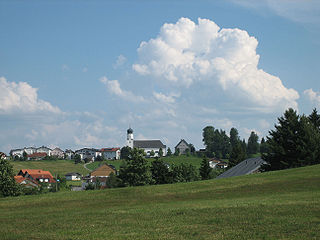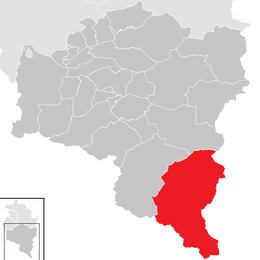
Vorarlberg is the westernmost federal state (Bundesland) of Austria. It has the second-smallest area after Vienna, and although it has the second-smallest population, it also has the second-highest population density. It borders three countries: Germany, Switzerland, and Liechtenstein. The only Austrian state that shares a border with Vorarlberg is Tyrol to the east.

Bludenz is a town in the Austrian state of Vorarlberg. It is the administrative seat of Bludenz District, which encompasses about half of the state's territory.

The Silvretta Alps are a mountain range of the Central Eastern Alps shared by Tirol, Vorarlberg and Graubünden (Switzerland). The Austrian states of Tirol and Vorarlberg are connected by a pass road. The majority of the peaks are elevated above three thousand metres and are surrounded by glaciers. Thus, the area is also known as the "Blue Silvretta".

The Rätikon is a mountain range of the Central Eastern Alps, located at the border between Vorarlberg, Liechtenstein and Graubünden. It is the geological border between the Eastern and Western Alps and stretches from the Montafon as far as the Rhine. In the south, the Prättigau is its limit, and in the north, it is the Walgau. In the east, it borders the Silvretta groups. The Rätikon mountain range derives its name from Raetia, a province of the Roman Empire, named after the Rhaetian people.
Montafon is a 39 km long valley in the federal state of Vorarlberg (Austria) that is crossed by the river Ill (Vorarlberg). It extends from the city of Bludenz and the Verwall Alps in the north, to the Silvretta and Rätikon mountain range in the south. Piz Buin is with 3312m the highest peak within the Silvretta mountain range. The area has a population of 16.642 people.

Schruns is a municipality in the Montafon valley in the Austrian state of Vorarlberg in the Bludenz district.

Tschagguns is a village in the Montafon valley, Bludenz district in the Austrian state of Vorarlberg. Tschagguns offers skiing with its own ski resort called Golm. Tschagguns offers hiking, mountain biking, winter sports and much more. Gauertal is a valley found in Tschagguns between Mittagspitze and Golm. It is famous for the "3 Türme" which means 3 Towers.

Lochau is a municipality in the Austrian state of Vorarlberg. It is located on Lake Constance, in the Bregenz district near the border to Germany.

Au is a town in the Bregenz Forest in the Austrian state of Vorarlberg, part of the district of Bregenz.

Schwarzenberg is a municipality in the Bregenz Forest in the Austrian state of Vorarlberg, part of the district of Bregenz. Schwarzenberg has an area of 25.76 km². It lies south of Lake Constance. The village center is heritage-protected for its clapboard houses.

Fontanella is a municipality in the Austrian state of Vorarlberg.

Sankt Anton im Montafon is a town in the Montafon valley in the district of Bludenz in the Austrian state of Vorarlberg.

Damüls is a municipality and popular tourism resort in the district of Bregenz in the Austrian state of Vorarlberg. Damüls also holds the world record of the municipality with the most annual snowfall in Europe – the average is 9.30 meters per year. In 2006, Damüls was awarded the honorary title "the snowiest village in the world".

Brand is a municipality in the district of Bludenz in the Austrian state of Vorarlberg.

Doren is a municipality in the district of Bregenz in the Austrian state of Vorarlberg.

Schröcken is a municipality in the district of Bregenz in the Austrian state of Vorarlberg.

Sibratsgfäll is a municipality in the district of Bregenz in the Austrian state of Vorarlberg.

Sulzberg is a municipality in the district of Bregenz in the Austrian state of Vorarlberg.

The Silvretta Montafon ski area is located in the Montafon valley in Vorarlberg (Austria). It is one of Austria's ten largest ski areas. The Silvretta Montafon ski area originally existed of the two ski areas Silvretta Nova and Hochjoch that have been merged in 2008.

Stuben am Arlberg is a winter sports resort in the municipality Klösterle in the Austrian province of Vorarlberg. It is located at 1410 m AA and counts 90 inhabitants.

























